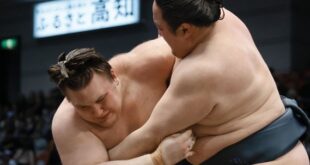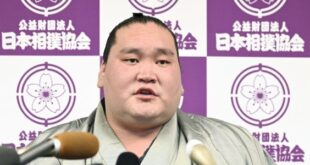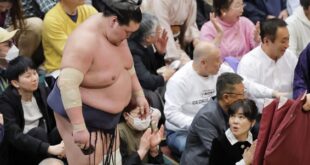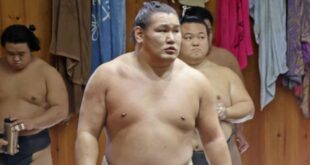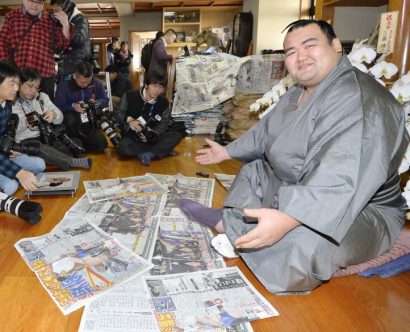
Kotoshogiku perpétue la tradition tardive de sa heya
A 31 ans et 11 mois, Kotoshogiku est devenu le premier grand champion d’origine japonaise à remporter un tournoi en 10 ans en battant l’ôzeki Goeido en dernière journée du hatsu basho 2016 dimanche au Ryogoku Kokugikan. À la suite de sa victoire, Kotoshogiku sera admissible à une promotion au rang de yokozuna s’il parvient à s’emparer du titre en mars prochain.
« Il y avait des fois où je me sentais tellement perdu que j’aurais pu prendre ma retraite et enfiler la veste bleue que porte le personnel de l’association de sumo« , a déclaré Kotoshogiku lors de la conférence de presse au lendemain de sa grande victoire.
« Mais ces moments difficiles ont fait de moi celui que je suis aujourd’hui, c’est aussi ce qui m’a permis de gagner«
Kotoshogiku devient le troisième plus vieux champion de sumo depuis que le système de six basho annuel a pris effet en 1958.
Kotozakura, l’ancien maître de l’écurie Sadogatake, est devenu yokozuna quand il avait 32 ans et 1 mois, après avoir combattu durant 60 tournois.
Également de la Sadogatake beya, Kotomitsuki est à égalité pour être le deuxième plus lent à atteindre la promotion d’ôzeki avec 44 basho.
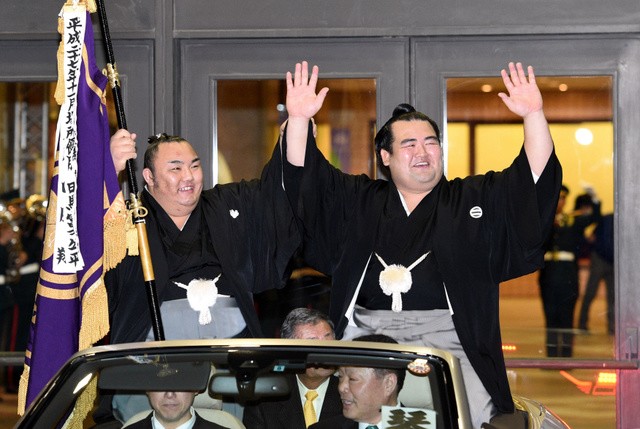
L’ancien Kotoinazuma, lui aussi formé à la Sadogatake beya aujourd’hui entraîneur sous le nom d’ancien Kumegawa, a combattu pas moins de 100 tournois avant d’obtenir son premier « Sansho » (l’un des trois prix spéciaux qui récompenses une performance exceptionnelle, un esprit combatif ou la technique).
Il lui a fallu 106 basho – la deuxième plus longue progression – pour être promu chez les sanyaku, les trois rangs juste en dessous de yokozuna.
Toujours de cette même heya, l’ancien lutteur Kotokaze (actuel Oguruma oyakata), est descendu de sekiwake jusqu’en division makushita. En surmontant sa blessure au genou, il est parvenu à remonter jusqu’à devenir ôzeki.
« Voilà la tradition de notre écurie« , a déclaré Kotonowaka, qui a succédé en tant que maître à la Sadogatake beya en 2005.
Si Kotoshogiku réussit en mars à atteindre le rang de yokozuna à 32 ans et 2 mois, il réécrira le record de lenteur de son ancien maître Kotozakura.
Plus tard dans la journée de lundi, le conseil de délibération pour la promotion des yokozuna a convenu que Kotoshogiku méritera une promotion s’il gagne en mars.
« Gagner deux championnats consécutifs servira de base pour la recommandation à sa promotion« , a déclaré le président du conseil Hiroshige Moriya après que le concile se soit réussi au Ryogoku Kokugikan de Tokyo. « Si il est juste finaliste, cela dépendra de la manière dont il aura combattu« .
Le président de la NSK Hakkaku a dit : « Sa qualité sera décisive. A ce stade, on ne va pas à décider combien de victoires (seront nécessaires) ou quelque chose comme ça. »
English article by Kyodo :
Kotoshogiku maintains late-blooming stable tradition
At 31 years and 11 months, Kotoshogiku became the first Japan-born grand tournament champion in 10 years when he defeated Goeido on the final day of the New Year Grand Sumo Tournament at Ryogoku Kokugikan on Sunday. As a result of his victory, Kotoshogiku will be eligible for promotion to yokozuna with a title in March’s grand tournament.
« There were times I felt so lost I could have (retired and) put on the jacket for sumo association staff, » said Kotoshogiku at the morning-after press conference for winning wrestlers.
« But those tough times made me who I am today, which is why I was able to win. »
Kotoshogiku becomes the third oldest first-time champion since the current six-basho system took effect in 1958.
Kotozakura, the former Sadogatake stable master, became yokozuna for the first time when he was 32 years and 1 month old, competing in a record 60 basho before reaching sumo’s highest rank.
Also from the Sadogatake stable, Kotomitsuki tied for the second slowest to achieve ozeki promotion with 44 basho.
Former Sadogatake wrestler and current Kumegawa stable master Kotoinazuma fought in a record 100 tournaments before he earned his first « sansho » (the award for outstanding performance, fighting spirit and technique).
It took him 106 basho — the second longest ever — to earn his first promotion to the « sanyaku » ranks, the three just below yokozuna.
Former Sadogatake wrestler Kotokaze dropped from sekiwake all the way down to the makushita division, sumo’s third-tier, but overcame a knee injury to earn ozeki promotion.
« That’s the tradition of our stable, » said Kotonowaka, who took over as the Sadogatake stable master in 2005.
If Kotoshogiku succeeds in March and attains the yokozuna rank at 32 years and 2 months, he will rewrite the slow-pace record of his former stable master Kotozakura.
Later on Monday, the Japan Sumo Association’s Yokozuna Deliberation Council agreed that Kotoshogiku will deserve promotion if he wins in March.
« Winning consecutive championships will provide the basis for recommending his promotion, » council chairman Hideshige Moriya said after the council convened at Tokyo’s Ryogoku Kokugikan. « If he is runner-up, it will depend on how good he is. »
JSA chairman Hakkaku said, « His quality will be decisive. At this point, we’re not going to offer up how many wins (will be needed) or anything like that. »
Written by Kyodo
 Dosukoi, le site du sumo Sumo : actualités, résultats, dossiers, vidéos… toute la passion du sumo est sur Dosukoi!
Dosukoi, le site du sumo Sumo : actualités, résultats, dossiers, vidéos… toute la passion du sumo est sur Dosukoi!
